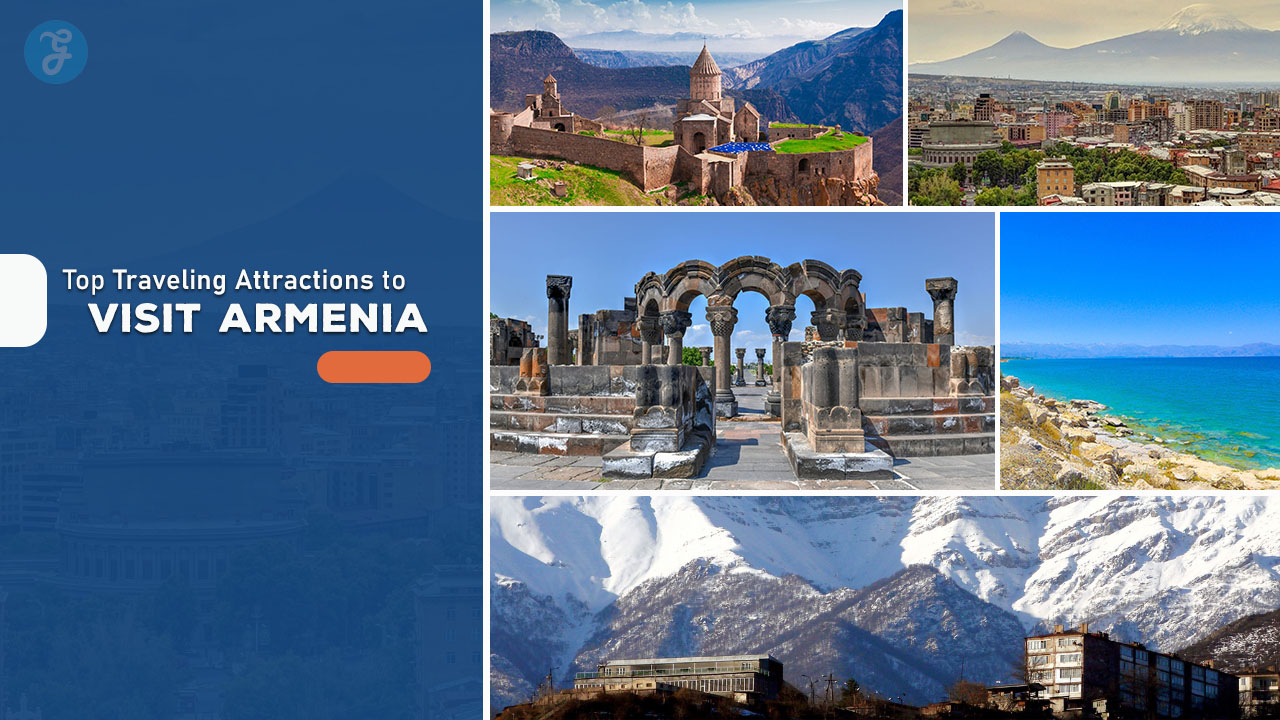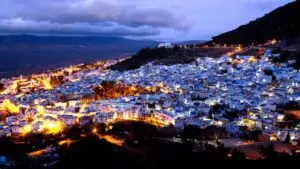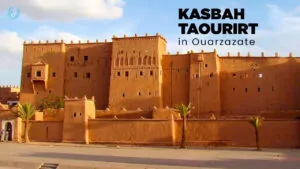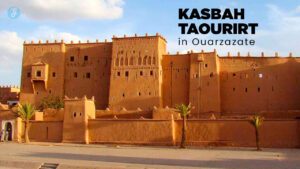Armenia, a small country nestled in the South Caucasus region, is a hidden gem for travelers seeking rich history, stunning landscapes, and warm hospitality. This ancient land, often called the “open-air museum,” boasts a history spanning over 3,000 years. From its towering mountains and deep gorges to its ancient monasteries and vibrant cities, Armenia offers a diverse range of attractions for every type of traveler.
In this comprehensive guide, we’ll explore the 30 top traveling attractions that make Armenia a must-visit destination. Whether you’re interested in historical sites, natural wonders, or cultural experiences, Armenia has something to offer. Let’s embark on a journey through this captivating country and discover why it should be on your travel bucket list.
Read More: Best Things to do in Paris
1. Yerevan: The Pink City
Our journey begins in Yerevan, the capital city of Armenia. Yerevan, often referred to as the “Pink City” because many of its buildings feature the rose-colored volcanic tufa stone, embodies a blend of ancient history and modern vibrancy.
Key attractions in Yerevan include:
- Republic Square: The heart of the city, featuring impressive architectural ensembles and the famous “singing fountains.”
- Cascade Complex: A giant limestone stairway housing the Cafesjian Center for the Arts and its impressive modern art collection.
- Matenadaran: The Institute of Ancient Manuscripts, home to over 17,000 manuscripts and 30,000 other documents.
- Vernissage Market: An open-air flea market where you can find traditional Armenian crafts, souvenirs, and artwork.
Yerevan’s history dates back to the 8th century BCE, making it one of the world’s oldest continuously inhabited cities. Despite its ancient roots, Yerevan boasts a vibrant cafe culture, a thriving arts scene, and numerous parks and green spaces.
2. Geghard Monastery
Located about 40 kilometers east of Yerevan, Geghard Monastery is a UNESCO World Heritage site and one of Armenia’s most fascinating attractions. The monastery’s name, meaning “spear” in Armenian, alludes to the spear, allegedly brought here, that wounded Jesus during his crucifixion.
Geghard’s uniqueness lies in its partial carving out of the adjacent mountain. Several churches and tombs, carved directly into the rock face, are part of the complex. Local vocal groups frequently perform traditional Armenian spiritual songs inside the rock-cut chambers, showcasing the incredible acoustics.
The 4th century saw the founding of the monastery, while 1215 saw the construction of the main cathedral. The intricate stone carvings and khachkars (cross-stones) throughout the complex are prime examples of medieval Armenian art.
3. Garni Temple
The Garni Temple, which is often visited in conjunction with Geghard Monastery, is the only remaining Greco-Roman colonnaded building in Armenia and the former Soviet Union. Built in the 1st century AD, it is believed to have been a temple dedicated to the sun god Mihr.
The temple stands on a cliff overlooking the Azat River Gorge, offering breathtaking views of the surrounding landscape. The symmetry and proportions of the temple are remarkable, showcasing the influence of classical architecture in ancient Armenia.
Next to the temple, you can find the remains of a royal palace and a bathhouse with a well-preserved mosaic floor. The site also includes a modern visitors’ center where you can learn more about the history and significance of this ancient complex.
4. Lake Sevan
Often called the “Pearl of Armenia,” Lake Sevan is one of the largest freshwater high-altitude lakes in Eurasia. Situated about 60 kilometers northeast of Yerevan, this massive blue lake spans an area of 1,242 square kilometers, encircled by mountains.
Key attractions around Lake Sevan include:
- Sevanavank Monastery: A 9th-century monastery complex perched on a peninsula, offering stunning views of the lake.
- Beaches: During the summer months, there are several beaches along the shoreline where you can swim, sunbathe, or enjoy water sports.
- Hayravank Monastery: A 9th-century Armenian monastery on the lake’s western shore.
- Local cuisine: Try the famous Sevan trout (ishkhan) at one of the lakeside restaurants.
Lake Sevan is not just a beautiful natural attraction but also an important part of Armenia’s ecosystem and economy. It’s a popular summer destination for both locals and tourists, offering a refreshing escape from the heat of the lowlands.
5. Tatev Monastery
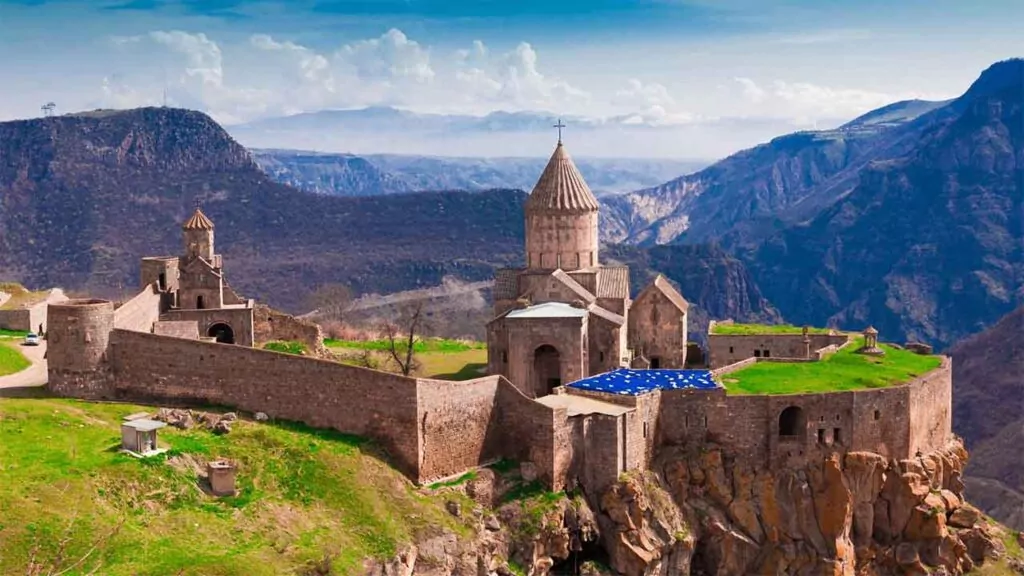
Perched on the edge of a deep gorge in southeastern Armenia, Tatev Monastery is one of the most spectacular sights in the country. Built in the 9th century, this monastery was a significant spiritual and educational center in medieval Armenia.
The monastery complex includes three churches, a library, a dining hall, and other structures. The main church, dedicated to Sts. Paul and Peter, is an impressive example of Armenian medieval architecture.
To reach Tatev, visitors can take the “Wings of Tatev,” the world’s longest non-stop double-track cable car. This 5.7-kilometer ride offers breathtaking views of the Vorotan Gorge and surrounding mountains.
The monastery also houses the famous Gavazan Column, or swinging staff. This 8-meter octagonal pillar was built in 904 and is famous for its ability to tilt and return to its upright position, serving as an early warning system for seismic activity.
6. Khor Virap Monastery
Khor Virap is one of Armenia’s most iconic landmarks, famous for its stunning location and historical significance. This monastery, located near the Turkish border, provides unparalleled views of Mount Ararat, the biblical mountain where Noah’s Ark is believed to have rested after the great flood.
The monastery’s name, which translates to “deep dungeon” in Armenian, alludes to the pit where Gregory the Illuminator, the patron saint of Armenia, spent 13 years before curing King Tiridates III of a disease. This event led to Armenia becoming the first country to adopt Christianity as its official religion in 301 AD.
A narrow ladder allows visitors to descend into the pit that once held St. Gregory. The 17th century saw the construction of the current church, which replaced earlier structures from the 5th century.
7. Noravank Monastery
The Amaghu River creates a narrow gorge that houses Noravank, a 13th-century Armenian monastery renowned for its striking architecture and dramatic natural setting. The complex includes two churches: the larger Surb Astvatsatsin (Holy Mother of God) and the smaller Surb Karapet.
What sets Noravank apart is its unique architectural features, particularly the sculptural work of Momik, one of medieval Armenia’s renowned architects and artisans. The relief carvings on the church walls, as well as the khachkars (crossstones) in the complex, are exceptional examples of Armenian stone carving art.
Steep, brick-red cliffs surround the monastery, striking a stunning contrast with the ochre-colored stone of the monastery buildings. The play of light on these surfaces throughout the day makes Noravank a photographer’s dream.
Read Also: Best Places to Visit in Croatia
8. Dilijan National Park
Often called the “Switzerland of Armenia,” Dilijan is a lush, forested town located in the Tavush Province. Dilijan National Park, established in 2002, covers over 24,000 hectares and is known for its rich biodiversity and stunning landscapes.
Key attractions in and around Dilijan include:
- Hiking trails: The park offers numerous hiking trails through dense forests and alpine meadows.
- Lake Parz: A small, picturesque lake perfect for picnics and relaxation.
- Haghartsin Monastery: A 13th-century monastery complex hidden in the forest.
- Goshavank Monastery: Another medieval monastery famous for its intricate khachkars.
Dilijan is also known for its mineral water springs and traditional Armenian architecture. The town’s Old Dilijan Complex on Sharambeyan Street showcases restored 19th-century buildings, giving visitors a glimpse into traditional Armenian town life.
9. Amberd Fortress
Perched on the slopes of Mount Aragats at an elevation of 2,300 meters, Amberd Fortress is one of the best-preserved medieval military complexes in Armenia. The name Amberd means “fortress in the clouds” in Armenian, aptly describing its lofty location.
Amberd was built in the 7th century and expanded in the 11th century. It served as a summer residence for Armenian royalty and a key defensive stronghold. The complex includes a church, a bathhouse, and a secret passage to the nearby river.
The fortress offers panoramic views of the surrounding mountains and the Ararat plain. Through centuries of invasions and wars, the harsh climate and difficult access helped to preserve Amberd.
10. Etchmiadzin Cathedral
Etchmiadzin Cathedral, often considered the Armenian equivalent of the Vatican, is the Armenian Apostolic Church’s mother church and the world’s first state-built church. Located in the city of Vagharshapat (also known as Etchmiadzin), about 20 kilometers west of Yerevan, this UNESCO World Heritage site is a must-visit for anyone interested in religious history and architecture.
Tradition holds that Armenia, the first country to adopt Christianity as a state religion, built the cathedral between 301-303 AD. The current building, however, dates mainly from the 5th century, with later additions and renovations.
The cathedral complex includes:
- The main cathedral
- The Treasury Museum houses religious relics such as a piece of Noah’s Ark and the Holy Lance.
- Several churches and chapels
- The residence of Catholicos, the head of the Armenian Apostolic Church
Etchmiadzin remains an active place of worship and an important pilgrimage site for Armenians worldwide.
11. Zvartnots Cathedral Ruins
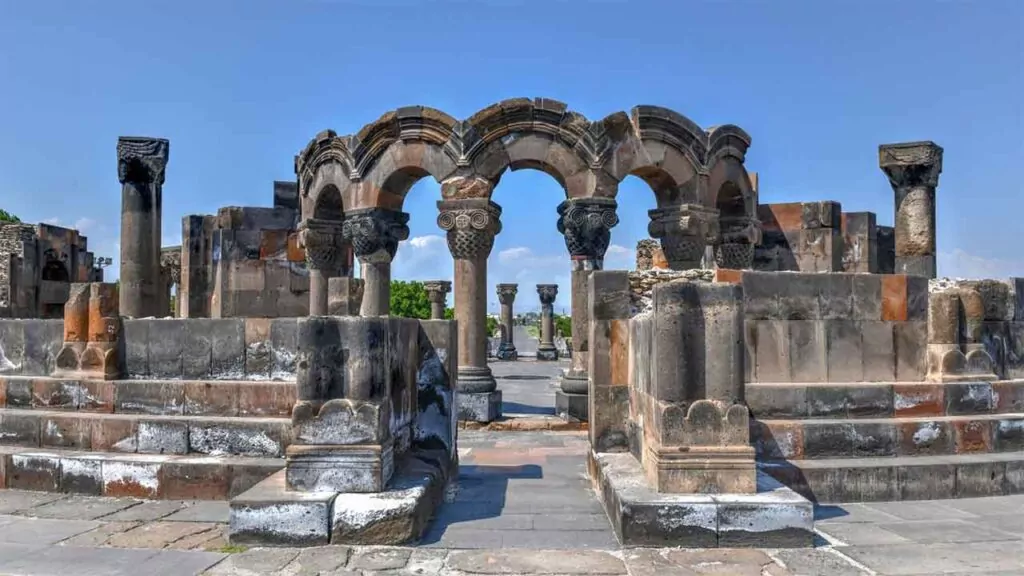
Located near Etchmiadzin, Zvartnots Cathedral was once one of the most impressive structures of medieval Armenian architecture. Built in the 7th century, this circular, three-story church stood 45 meters high and 37 meters in diameter.
Although the cathedral collapsed in the 10th century due to an earthquake, the ruins still provide a glimpse of its former glory. The site is now a UNESCO World Heritage site, and it includes a small museum with models of the cathedral’s original appearance.
The unique design of Zvartnots influenced Armenian and Byzantine architecture for centuries. The ruins are particularly beautiful at sunset, when the warm light brings out the rich colors of the stone.
12. Areni-1 Cave Complex
For history and archaeology enthusiasts, the Areni-1 cave complex is a fascinating destination. Located in the Vayots Dzor region, this site has yielded some of the most important archaeological discoveries in recent years.
Key findings in the Areni-1 cave include:
- The world’s oldest leather shoe (5,500 years old)
- The world’s oldest winery (6,100 years old)
- The preserved human brain tissue is over 5,000 years old.
These discoveries have provided valuable insights into Chalcolithic (Copper Age) culture in the region. While the cave itself is not open to the public in order to preserve the archaeological site, visitors can see some of the artifacts in local museums and learn about the excavations at the nearby information center.
The surrounding Areni region is also famous for its wine production, continuing a tradition that began over 6,000 years ago.
13. Jermuk
Jermuk is a mountain spa town famous for its hot springs and mineral waters. Located in the southern part of Armenia, it’s a popular destination for both medical tourism and relaxation.
Jermuk’s main attractions include:
- Jermuk Waterfall: A 70-meter-high waterfall nicknamed “Mermaid’s Hair.”
- Drinking galleries: Several pavilions where you can taste different types of mineral water straight from the source.
- Jermuk Forest: A beautiful area for hiking and picnicking.
- Ski resort: In winter, Jermuk transforms into a small but charming ski resort.
The town is also home to several sanatoriums where visitors can undergo various health treatments using the local mineral waters. The surrounding mountains and forests offer opportunities for hiking, horseback riding, and other outdoor activities.
You Can Read Also: Hidden Gems in Poland
14. Gyumri
Gyumri, Armenia’s second-largest city, is a place of resilience and cultural richness. A powerful earthquake in 1988 devastated the city, but it has rebuilt itself and preserved much of its 19th-century architecture and artistic heritage.
Key attractions in Gyumri include:
- Vartanants Square: The central square featuring impressive black tuff stone buildings.
- Dzitoghtsyan Museum: Housed in a 19th-century mansion, it showcases the city’s history and culture.
- Aslamazyan Sisters Gallery: displays works by the famous Aslamazyan sisters, renowned Armenian artists.
- Gyumri Fortress: Built in the 19th century as part of the Russian Empire’s defensive system.
Gyumri, often referred to as the “city of arts and crafts,” is renowned for its artistic atmosphere. The city’s old town, Kumayri Historic District, features well-preserved examples of 19th-century urban architecture.
15. Haghpat Monastery
Haghpat Monastery, a UNESCO World Heritage Site, is one of the finest examples of medieval Armenian architecture. Built between the 10th and 13th centuries, this monastic complex played a significant role in the country’s spiritual and cultural life.
The monastery includes several churches, a library, refectory, and bell tower. Its location on a hillside allows for panoramic views of the Debed River gorge. The main church, St. Nshan, is famous for its 13th-century frescoes and intricate stone carvings.
In medieval Armenia, Haghpat was an important learning center. Numerous illuminated manuscripts from the monastery’s scriptorium are on display at the Matenadaran in Yerevan.
16. Sanahin Monastery
Sanahin Monastery, located in Lori Province, is another UNESCO World Heritage site frequently visited with Haghpat. The name Sanahin literally means “this one is older than that one” in Armenian, likely referring to its slightly earlier foundation compared to Haghpat.
Sanahin was a renowned educational center in medieval Armenia, housing a famous academy where students studied science, medicine, and other subjects. The complex includes several churches, a library, and a unique three-story bell tower.
The monastery is famous for its khachkars (cross-stones), particularly the “Amenaprkich” (All-Savior) khachkar, considered one of the finest examples of Armenian medieval art.
17. Debed Canyon
The Debed Canyon, located in the Lori Province, is a natural wonder that also houses several important cultural sites. The canyon, which the Debed River carved, offers breathtaking views and is a haven for hikers and nature lovers.
Key attractions in and around Debed Canyon include:
- Haghpat and Sanahin Monasteries (mentioned earlier)
- Akhtala Monastery: Known for its well-preserved frescoes
- Odzun Church: A 6th-century basilica with unique architectural features
- Horomayri Monastery: A small monastery complex built into a cliff face
The canyon is also part of the Transcaucasian Trail, a long-distance hiking trail connecting Armenia and Georgia. The area is rich in biodiversity, home to numerous species of plants and animals.
18. Tsaghkadzor
Tsaghkadzor, meaning “valley of flowers” in Armenian, is a popular year-round resort town. Located about 50 kilometers north of Yerevan, it’s known for its ski resort in winter and its cool climate and hiking opportunities in summer.
Key attractions in Tsaghkadzor include:
- Ski resort: Lifts reaching up to 2,819 meters
- Kecharis Monastery: An 11th- to 13th-century monastic complex.
- Armenia Writer’s House: A unique architectural complex built in the 1930s
- Botanical Garden: Home to numerous species of plants, including many endemic to Armenia
In addition to skiing and snowboarding in winter, visitors can enjoy hiking, mountain biking, and horseback riding in the warmer months. The town also has several spas and wellness centers, making it a wonderful place for relaxation.
19. Aragats Mountain
Mount Aragats, the highest peak in Armenia at 4,090 meters, is a dormant volcano and a paradise for hikers and nature enthusiasts. The mountain has four peaks, with the southern peak being the most accessible to climbers.
Key attractions on and around Mount Aragats include:
- Kari Lake: A small alpine lake at 3,200 meters, accessible by car
- Amberd Fortress (mentioned earlier)
- Byurakan Observatory: One of the former Soviet Union’s main astronomy centers
- Alphabet Alley: A monument featuring giant Armenian letter sculptures.
The mountain and its surroundings offer diverse flora and fauna, including many species endemic to the region. Ancient petroglyphs dotted the area, adding a cultural dimension to the natural beauty.
20. Lastiver
Lastiver is a hidden gem in northeastern Armenia’s Tavush region. It’s known for its pristine forests, waterfalls, and unique cave dwellings carved into the rock face.
Key attractions in Lastiver include:
- Cave dwellings: ancient dwellings carved into the cliffs, some of which have been converted into guesthouses.
- Waterfalls: Several beautiful waterfalls in the area, including a 20-meter-high one
- Hiking trails: Numerous trails through lush forests and along river gorges
- Eco-camps: Several eco-friendly camping sites for those who want to immerse themselves in nature
Lastiver is an excellent destination for eco-tourism, offering opportunities for hiking, rock climbing, and camping. The area is also rich in biodiversity, home to numerous species of plants and animals.
21. Goris
Goris, a picturesque town in southern Armenia, is known for its unique architecture and stunning natural surroundings. The town’s center features charming stone houses with red tile roofs, set against a backdrop of rocky mountains.
Key attractions in and around Goris include:
- Old Goris Cave Dwellings: Ancient cave homes carved into the hillsides
- The Tatev Monastery was previously mentioned, along with the Wings of Tatev cable car.
- Goris Local Lore Museum: Showcasing the region’s history and culture
- Karahunj (Zorats Karer): An ancient megalithic site often called the “Armenian Stonehenge.”
Goris serves as an excellent base for exploring the surrounding region, including Tatev Monastery and the villages of Syunik Province.
22. Noravank Gorge
Although we have already discussed Noravank Monastery, the gorge in which it is located merits its own mention. The Amaghu River carved the Noravank Gorge, which has dramatic towering red cliffs that serve as a backdrop for the 13th-century monastery.
The gorge is known for its:
- Stunning rock formations in various shades of red and orange
- Rich flora and fauna, including several species endemic to Armenia
- There are excellent hiking opportunities with trails of varying difficulty.
- Spectacular views, especially at sunrise and sunset when the light brings out the vivid colors of the rocks
Visitors can explore the gorge on foot or by car, with several viewpoints offering breathtaking vistas of the monastery and surrounding landscape.
23. Selim Caravanserai
Located on the Selim Pass of the ancient Silk Road, Selim Caravanserai is a well-preserved 14th-century inn that once sheltered travelers and their animals. It’s one of the best examples of Armenian secular architecture from the medieval period.
Selim Caravanserai has the following key features:
- Basalt stone construction with intricate carvings
- A main hall divided into three naves
- There are animal stalls on both sides of the main hall.
- An inscription in Armenian and Arabic, indicating its construction date and purpose
The caravanserai offers a glimpse into the lives of medieval traders and travelers. Its location also allows for panoramic views of the surrounding mountains and Lake Sevan in the distance.
24. Khndzoresk Cave Village
Up until the mid-20th century, people lived in Khndzoresk, a unique cave village in the Syunik Province. The village consists of both natural and man-made caves carved into the soft rock of a deep gorge.
Khndzoresk’s key attractions include:
- Cave dwellings: Hundreds of cave homes spread across the gorge
- Swinging bridge: A 160-meter-long suspension bridge connecting the two sides of the gorge
- St. Hripsime Church: A 17th-century church overlooking the cave village
- Mkhitar Sparapet’s Mausoleum: The tomb of an 18th-century Armenian military leader
Visitors can explore the cave dwellings and learn about the unique lifestyle of their former inhabitants. The site offers a fascinating blend of natural beauty and human history.
25. Areni Wine Country
The Areni region, located in the Vayots Dzor province, is the heart of Armenia’s wine country. For thousands of years, people have cultivated the Areni grape variety in this area, making it famous.
Key attractions in Areni Wine Country include:
- Areni-1 Cave Complex (mentioned earlier)
- Local wineries: Many offer tours and tastings.
- Noravank Monastery and Gorge (mentioned earlier).
- Annual Areni Wine Festival: Held in October, celebrating the region’s winemaking tradition
Visitors can explore the vineyards, learn about traditional winemaking methods, and taste a variety of local wines. The region’s beautiful landscapes and historical sites add to the wine tasting experience.
26. Shikahogh State Reserve
Shikahogh State Reserve, located in southern Armenia, is the country’s second-largest forest reserve. It’s home to a rich diversity of flora and fauna, including several species endemic to Armenia.
Key features of Shikahogh State Reserve include:
- Diverse ecosystems: From dense forests to alpine meadows
- Rare animal species: including leopards, bears, and bezoar goats
- Numerous hiking trails
- Spectacular waterfalls and mountains
The reserve offers excellent opportunities for eco-tourism, bird watching, and nature photography. It’s a must-visit for nature lovers and those seeking to experience Armenia’s wild landscapes.
27. Byurakan Observatory
Byurakan Observatory, located on the slopes of Mount Aragats, is one of Eastern Europe’s and the former Soviet Union’s primary astronomy centers. Founded in 1946 by Viktor Ambartsumian, it has played a significant role in astrophysical research.
Key attractions at Byurakan Observatory include:
- 2.6 m telescope: one of the largest in the region
- Visitor center: offering educational programs and night sky observations
- Viktor Ambartsumian House-Museum: Dedicated to the life and work of the observatory’s founder
- Scenic location: offering beautiful views of Mount Ararat and the Ararat plain
Visitors can tour the observatory, learn about its groundbreaking research, and even observe the night sky through telescopes (by prior arrangement).
28. Garni Gorge
While the Temple of Garni is a well-known attraction, the gorge below it is equally impressive. The “Symphony of Stones,” which are distinctive rock formations in the Garni Gorge that the Azat River carved out, are well-known.
Key attractions in Garni Gorge include:
- Symphony of Stones: spectacular basalt columnar joints forming a natural amphitheater
- Havuts Tar Monastery: A hiking trail leads to the medieval monastery ruins.
- Khosrov Forest State Reserve: One of the oldest protected areas in the world
- Natural bridge: A picturesque stone bridge over the Azat River
Visitors can either hike down to the gorge from the Temple of Garni or take a 4×4 vehicle. The area offers excellent opportunities for hiking, picnicking, and photography.
29. Yerevan Cascade
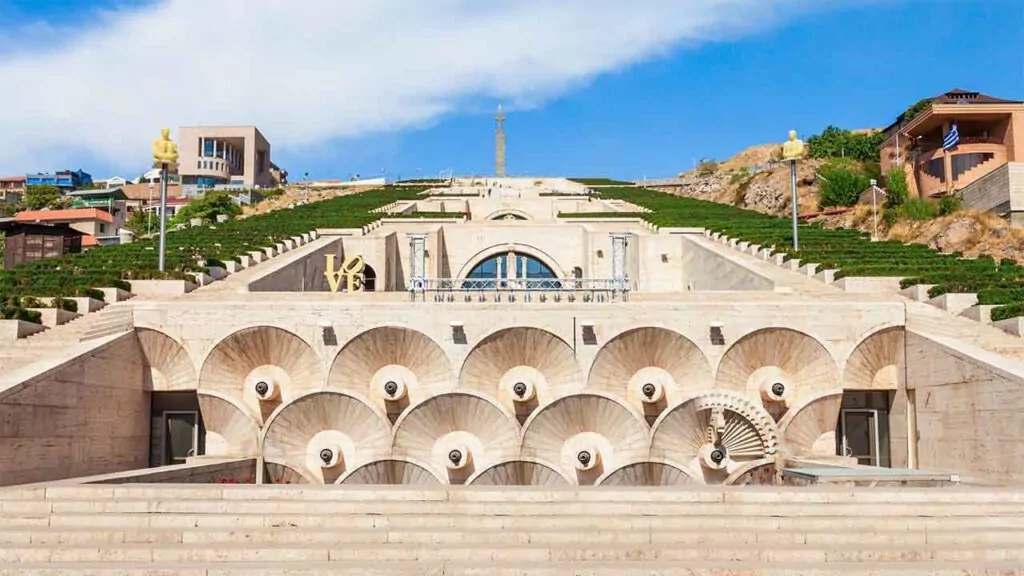
While we mentioned the Cascade Complex briefly when discussing Yerevan, it deserves its own entry as a unique attraction. The Cascade, a massive limestone stairway, connects Yerevan’s downtown Kentron area with the Monument neighborhood.
Key features of the Yerevan Cascade include:
- The Cafesjian Center for the Arts houses a collection of modern art.
- Sculpture Garden: Featuring works by renowned international artists.
- Panoramic views: The cascade’s summit offers stunning views of Yerevan and Mount Ararat.
- Multiple levels: each with its own architectural style and artwork
Visitors can climb the stairs for free or use the escalators inside the structure (for a small fee). The illumination of the cascade at night enhances its beauty.
30. Lake Arpi National Park
Our final attraction is Lake Arpi National Park, located in the northwestern corner of Armenia. This high-altitude lake and its surrounding wetlands form an important ecosystem and bird habitat.
Key features of Lake Arpi National Park include:
- Lake Arpi: A large freshwater lake at 2,023 meters above sea level
- Diverse birdlife: over 190 species of birds, many of them rare or endangered.
- Unique Flora: Including several species endemic to the Caucasus region
- Traditional villages: showcasing rural Armenian life
The park offers opportunities for birdwatching, hiking, and experiencing traditional Armenian rural culture. It’s an excellent destination for those seeking off-the-beaten-path experiences in Armenia.
Conclusion
Armenia, with its rich history, diverse landscapes, and warm hospitality, offers a wealth of attractions for travelers. From ancient monasteries perched on cliff edges to lush forests and high-altitude lakes, from vibrant cities to traditional villages, Armenia has something to offer every type of traveler.
This list of 30 top attractions only scratches the surface of what Armenia has to offer. Each site not only showcases the country’s natural beauty or historical significance but also tells a story of Armenia’s long and complex history, its resilience, and its unique culture.
Whether you’re interested in history, nature, adventure, or culture, Armenia provides a unique and enriching travel experience. As you plan your visit, remember that each region of Armenia has its own character and charm, and even the journey between destinations can be an adventure in itself, with stunning landscapes and unexpected discoveries along the way.
As you explore these attractions and more, you’ll find that Armenia is not just a destination but an experience—one that will leave you with lasting memories and a deep appreciation for this small but mighty country in the South Caucasus.

